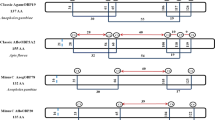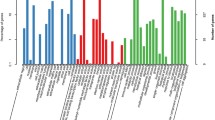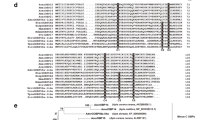Abstract
Solitary bees are major pollinators but their chemical communication system has been poorly studied. We investigated olfactory coding in Osmia cornuta from two perspectives, chemical and biochemical. We identified (E)-geranyl acetone and 2-hexyl-1,3-dioxolane, specifically secreted by females and males, respectively. A transcriptome analysis of antennae revealed 48 ORs (olfactory receptors), six OBPs (odorant-binding proteins), five CSPs (chemosensory proteins), and a single SNMP (sensory neuron membrane protein). The numbers of ORs and OBPs are much lower than in the honeybee, in particular, C-minus OBPs are lacking in the antennae of O. cornuta. We have expressed all six OBPs of O. cornuta and studied their binding specificities. The best ligands are common terpene plant odorants and both volatiles produced by the bee and identified in this work.


Similar content being viewed by others
Abbreviations
- OR:
-
Olfactory receptor
- OBP:
-
Odorant-binding protein
- CSP:
-
Chemosensory protein
- SNMP:
-
Sensory neuron membrane protein
- 1-NPN:
-
N-Phenyl-1-naphthylamine
- IPTG:
-
Isopropyl-1-thio-β-d-galacto-pyranoside
- SDS-PAGE:
-
Sodium dodecyl sulphate polyacrylamide gel electrophoresis
- GC/MS:
-
Gas-chromatography/mass spectrometry
- Amel :
-
Apis mellifera
- Bter :
-
Bombus terrestris
- Mrot :
-
Megachile rotundata
- Ocor :
-
Osmia cornuta
References
Slessor KN, Kaminski L-A, King GGS, Borden JH, Winston ML (1988) Semiochemical basis of the retinue response to queen honey bees. Nature 332:354–356
Slessor KN, Winston ML, Le Conte Y (2005) Pheromone communication in the honeybee (Apis mellifera L.). J Chem Ecol 31:2731–2745
Honeybee Genome Sequencing Consortium (2006) Insights into social insects from the genome of the honeybee Apis mellifera. Nature 443:931–949
Robertson HM, Wanner KW (2006) The chemoreceptor superfamily in the honey bee, Apis mellifera: expansion of the odorant, but not gustatory, receptor family. Genome Res 16:1395–1403
Galizia C, McIlwrath S, Menzel R (1999) A digital three-dimensional atlas of the honeybee antennal lobe based on optical sections acquired by confocal microscopy. Cell Tissue Res 295:383–394
Forêt S, Maleszka R (2006) Function and evolution of a gene family encoding odorant binding-like proteins in a social insect, the honey bee (Apis mellifera). Genome Res 16:1404–1413
Forêt S, Wanner KW, Maleszka R (2006) Chemosensory proteins in the honey bee: insights from the annotated genome, comparative analyses and expressional profiling. Insect Biochem Mol Biol 37:19–28
Danty E, Briand L, Michard-Vanhee C, Perez V, Arnold G, Gaudemer O, Huet D, Huet JC, Ouali C, Masson C, Pernollet JC (1999) Cloning and expression of a queen pheromone-binding protein in the honeybee: an olfactory-specific, developmentally regulated protein. J Neurosci 19:7468–7475
Briand L, Nespoulous C, Huet JC, Takahashi M, Pernollet JC (2001) Ligand binding and physico-chemical properties of ASP2, a recombinant odorant-binding protein from honeybee (Apis mellifera L.). Eur J Biochem 268:752–760
Briand L, Swasdipan N, Nespoulous C, Bezirard V, Blon F, Huet J-C, Ebert P, Pernollet JC (2002) Characterization of a chemosensory protein (ASP3c) from honeybee (Apis mellifera L.) as a brood pheromone carrier. Eur J Biochem 269:4586–4596
Dani FR, Iovinella I, Felicioli A, Niccolini A, Calvello MA, Carucci MG, Qiao H, Pieraccini G, Turillazzi S, Moneti G, Pelosi P (2010) Mapping the expression of soluble olfactory proteins in the honeybee. J Proteome Res 9:1822–1833
Iovinella I, Dani FR, Niccolini A, Sagona S, Michelucci E, Gazzano A, Turillazzi S, Felicioli A, Pelosi P (2011) Differential expression of odorant binding proteins in the mandibular glands of the honey bee according to caste and age. J Prot Res 10:3439–3449
Barrows E (1975) Mating behavior in halictine bees (Hymenoptera: Halictidae): III. Copulatory behavior and olfactory communication. Insect Sociaux 22:307–332
Schiestl FP, Ayasse M, Paulus HF, Loefstedt C, Hansson BS, Ibarra F, Francke W (2000) Sex pheromone mimicry in the early spider orchid (Ophrys sphegodes): patterns of hydrocarbons as the key mechanism for pollination by sexual deception. J Comp Physiol A 186:567–574
Borg-Karlson AK, Tengö J, Valterová I, Unelius CR, Taghizadeh T, Tolasch T, Francke W (2003) (S)-(+)-linalool, a mate attractant pheromone component in the bee Colletes cunicularius. J Chem Ecol 29:1–14
Conrad T, Paxton RJ, Barth FG, Francke W, Ayasse M (2010) Female choice in the red mason bee, Osmia rufa (L.) (Megachilidae). J Exp Biol 213:4066–4073
Ollerton J, Winfree R, Tarrant S (2011) How many flowering plants are pollinated by animals? Oikos 120:321–326
Quaranta M, Medrzycki P, Porrini C, Romagnoli F, Celli G et al (2004) Wild bees in agroecosystems and semi-natural landscapes. 1997–2000 collection period in Italy. B Insectol 57:11–61
Potts SG, Biesmeijer JC, Bommarco R, Felicioli A, Fischer M et al (2011) Developing European conservation and mitigation tools for pollination services: approaches of the STEP (Status and Trends of European Pollinators) project. J Apicul Res 50:152–164
Krunic M, Pinzauti M, Felicioli A, Stanisavljevic L (1995) Further observations on Osmia cornuta Latr. and O. rufa L. as alternative fruit pollinators, domestication and utilization. Arch Biol Sci Belgrade 47:59–66
Krunic M, Stanisavljevic L, Pinzauti M, Felicioli A (2005) The accompanying fauna of Osmia cornuta and Osmia rufa and effective measures of protection. B Insectol 58:141–152
Pitts-Singer TL, Bosch J (2010) Nest establishment, pollination efficiency, and reproductive success of Megachile rotundata (Hymenoptera: Megachilidae) in relation to resource availability in field enclosures. Environ Entomol 39:149–158
Stanley CA, Pitts-Singer TL, Bosch J (2011) Influence of rough handling on Osmia lignaria (Hymenoptera: Megachilidae) nest establishment in commercial orchards. J Econ Entomol 104:750–752
Ha TS, Smith DP (2006) A pheromone receptor mediates 11-cis-vaccenyl acetate induced responses in Drosophila. J Neurosci 26:8727–8733
Xu P, Atkinson R, Jones DN, Smith DP (2005) Drosophila OBP LUSH is required for activity of pheromone-sensitive neurons. Neuron 45:193–200
Benton R, Vannice KS, Vosshall LB (2007) An essential role for a CD36-related receptor in pheromone detection in Drosophila. Nature 450:289–293
Vogt RG, Miller NE, Litvack R, Fandino RA, Sparks J, Staples J, Friedman R, Dickens JC (2009) The insect SNMP gene family. Insect Biochem Mol Biol 39:448–456
Xin J, Ha TS, Smith DP (2008) SNMP is a signaling component required for pheromone sensitivity in Drosophila. Proc Natl Acad Sci USA 105:10996–11001
Clyne PJ, Warr CG, Freeman MR, Lessing D, Kim J, Carlson JR (1999) A novel family of divergent seven-transmembrane proteins: candidate odorant receptors in Drosophila. Neuron 22:327–338
Vosshall LB, Amrein H, Morozov PS, Rzhetsky A, Axel R (1999) A spatial map of olfactory receptor expression in the Drosophila antenna. Cell 96:725–736
Allison F, Carey AF, Wang G, Su C-Y, Zwiebel LJ, Carlson JR (2010) Odorant reception in the malaria mosquito Anopheles gambiae. Nature 464:66–72
Vogt RG, Riddiford LM (1981) Pheromone binding and inactivation by moth antennae. Nature 293:161–163
Vogt RG (2005) Molecular basis of pheromone detection in insects. In: Gilbert LI, Iatrou K, Gill S (eds) Comprehensive insect physiology biochemistry pharmacology and molecular biology, vol 3., Endocrinology, Elsevier, London, pp 753–804
Pelosi P, Zhou J-J, Ban LP, Calvello M (2006) Soluble proteins in insect chemical communication. Cell Mol Life Sci 63:1658–1676
Laughlin JD, Ha TS, Jones DN, Smith DP (2008) Activation of pheromone-sensitive neurons is mediated by conformational activation of pheromone-binding protein. Cell 133:1255–1265
Matsuo T, Sugaya S, Yasukawa J, Aigaki T, Fuyama Y (2007) Odorant-binding proteins OBP57d and OBP57e affect taste perception and host-plant preference in Drosophila sechellia. PLoS Biol 5:e118
Swarup S, Williams TI, Anholt RR (2011) Functional dissection of Odorant binding protein genes in Drosophila melanogaster. Genes Brain Behav 10:648–657
Sun YF, De Biasio F, Qiao HL, Iovinella I, Yang SX, Ling Y, Riviello L, Battaglia D, Falabella P, Yang XL, Pelosi P (2012) Two odorant-binding proteins mediate the behavioural response of aphids to the alarm pheromone (E)-β-farnesene and structural analogues. PLoS One 7:e32759
Qiao HL, Tuccori E, He XL, Gazzano A, Field LM, Zhou J–J, Pelosi P (2009) Discrimination of alarm pheromone (E)-β-farnesene by aphid odorant-binding proteins. Insect Biochem Mol Biol 39:414–419
Tegoni M, Campanacci V, Cambillau C (2004) Structural aspects of sexual attraction and chemical communication in insects. Trends Biochem Sci 29:257–264
Spinelli S, Lagarde A, Iovinella I, Legrand P, Tegoni M, Pelosi P, Cambillau C (2012) Crystal structure of Apis mellifera OBP14 a C-minus odorant-binding protein and its complexes with odorant molecules. Insect Biochem Mol Biol 42:41–50
Pesenti ME, Spinelli S, Bezirard V, Briand L, Pernollet JC, Tegoni M, Cambillau C (2008) Structural basis of the honey bee PBP pheromone and pH-induced conformational change. J Mol Biol 380:158–169
Pesenti ME, Spinelli S, Bezirard V, Briand L, Pernollet JC, Campanacci V, Tegoni M, Cambillau C (2009) Queen bee pheromone binding protein pH-induced domain swapping favors pheromone release. J Mol Biol 390:981–990
Angeli S, Ceron F, Scaloni A, Monti M, Monteforti G, Minnocci A, Petacchi R, Pelosi P (1999) Purification, structural characterization, cloning and immunocytochemical localization of chemoreception proteins from Schistocerca gregaria. Eur J Biochem 262:745–754
Tuccini A, Maida R, Rovero P, Mazza M, Pelosi P (1996) Putative odorant-binding proteins in antennae and legs of Carausius morosus Insecta, Phasmatodea. Insect Biochem Mol Biol 26:19–24
Mameli M, Tuccini A, Mazza M, Petacchi R, Pelosi P (1996) Soluble proteins in chemosensory organs of Phasmids. Insect Biochem Mol Biol 26:875–882
Marchese S, Angeli S, Andolfo A, Scaloni A, Brandazza A, Mazza M, Picimbon J-F, Leal WS, Pelosi P (2000) Soluble proteins from chemosensory organs of Eurycantha calcarata Insecta, Phasmatodea. Insect Biochem Mol Biol 30:1091–1098
Wanner KW, Willis LG, Theilmann DA, Isman MB, Feng Q, Plettner E (2004) Analysis of the insect os-d-like gene family. J Chem Ecol 30:889–911
Jacquin-Joly E, Vogt RG, Francois MC, Nagnan-Le Meillour P (2001) Functional and expression pattern analysis of chemosensory proteins expressed in antennae and pheromonal gland of Mamestra brassicae. Chem Senses 26:833–844
Picimbon JF (2003) Biochemistry and evolution of OBP and CSP proteins. In: Blomquist GJ, Vogt RG (eds) Insect pheromone biochemistry and molecular biology. Elsevier Academic Press, London, pp 539–566
Picimbon JF, Dietrich K, Angeli S, Scaloni A, Krieger J, Breer H, Pelosi P (2000) Purification and molecular cloning of chemosensory proteins from Bombyx mori. Arch Insect Biochem Physiol 44:120–129
Lartigue A, Campanacci V, Roussel A, Larsson AM, Jones TA, Tegoni M, Cambillau C (2002) X-ray structure and ligand binding study of a moth chemosensory protein. J Biol Chem 277:32094–32098
Tomaselli S, Crescenzi O, Sanfelice D, Ab E, Wechselberger R, Angeli S, Scaloni A, Boelens R, Tancredi T, Pelosi P, Picone D (2006) Solution structure of a chemosensory protein from the desert locust Schistocerca gregaria. Biochemistry 45:10606–10613
Jansen S, Chmelík J, Zídek L, Padrta P, Novák P, Zdráhal Z, Picimbon JF, Löfstedt C, Sklenár V (2007) Structure of Bombyx mori chemosensory protein 1 in solution. Arch Insect Biochem Physiol 66:135–145
Ban LP, Scaloni A, D’Ambrosio C, Zhang L, Yan YH, Pelosi P (2003) Biochemical characterisation and bacterial expression of an odorant-binding protein from Locusta migratoria. Cell Mol Life Sci 60:390–400
Calvello M, Guerra N, Brandazza A, D’Ambrosio C, Scaloni A, Dani FR, Turillazzi S, Pelosi P (2003) Soluble proteins of chemical communication in the social wasp Polistes dominulus. Cell Mol Life Sci 60:1933–1943
Ban LP, Zhang L, Yan YH, Pelosi P (2002) Binding properties of a locust’s chemosensory. Biochem Biophys Res Commun 293:50–54
Maleszka J, Foret S, Saint R, Maleszka R (2007) RNAi-induced phenotypes suggest a novel role for a chemosensory protein CSP5 in the development of embryonic integument in the honeybee Apis mellifera. Dev Genes Evol 217:189–196
Benton R, Sachse S, Michnick SW, Vosshall LB (2006) Atypical membrane topology and heteromeric function of Drosophila odorant receptors in vivo. PLoS Biol 4:e20
Vosshall LB, Hansson BS (2011) A unified nomenclature system for the insect olfactory coreceptor. Chem Senses 36:497–498
Felicioli A, Isidoro N, Romani R, Bin F, Pinzauti M (1998) Ethological and morphological analysis of mating behaviour in Osmia cornuta Latr. (Hymenoptera: Megachilidae). Insect Soc Life 2:137–144
Qiao H, He X, Schymura D, Ban L, Field L, Dani FR, Michelucci E, Caputo B, della Torre A, Iatrou K, Zhou JJ, Krieger J, Pelosi P (2011) Cooperative interactions between odorant-binding proteins of Anopheles gambiae. Cell Mol Life Sci 68:1799–1813
Acknowledgments
Y. X.-W. thanks the University of Pisa for a 1-year scholarship supporting his visit at the laboratory of A. Felicioli.
Author information
Authors and Affiliations
Corresponding author
Additional information
X.-W. Yin and I. Iovinella have contributed equally to this work.
Electronic supplementary material
Below is the link to the electronic supplementary material.
Rights and permissions
About this article
Cite this article
Yin, XW., Iovinella, I., Marangoni, R. et al. Odorant-binding proteins and olfactory coding in the solitary bee Osmia cornuta . Cell. Mol. Life Sci. 70, 3029–3039 (2013). https://doi.org/10.1007/s00018-013-1308-2
Received:
Revised:
Accepted:
Published:
Issue Date:
DOI: https://doi.org/10.1007/s00018-013-1308-2




